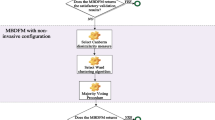Abstract
The development of understanding in the discipline of security science is just beginning. As the academic research on defining the domain of security science continues, so does the development of learning security-related concepts in the understanding of the knowledge structure. This study has considered a methodology for the portrayal of knowledge structures in the domain of electronic security and its associated concepts. It seeks to examine the understanding of novice learners’ perceptions of electronic security concepts through the knowledge structure approach. The multi-dimensional scaling technique has been applied to dissimilarity measures on a selection of concepts from the domain of electronic security. These concepts were considered as key ideas in the learning of electronic security. The formal knowledge structure for electronic security concepts was mapped for an expert group that was most familiar with the understanding of this domain of security science. In addition, two student groups from the Singapore Institute of Technical Education participated in the study, and produced concept maps for the same electronic security concepts. The structures of the novice groups when compared to the expert group lacked the definition of clusters of related concepts, and were interpreted as lacking the understanding of experts in this knowledge domain.





Similar content being viewed by others
References
Ausubel, D.P. (1966) Meaningful reception learning and the acquisition of concepts. In: H.J. Klausmeier and C.W. Harris (eds.) Analysis of Concept Learning. New York: Academic press.
Bennett, B. and Rolheiser, C. (2001) Beyond Monet: The Artful Science of Instructional Integration. Toronto: Bookation.
Brooks, D.J. (2006) Mapping the consensual knowledge of security risk management experts. Proceedings of the 7th Australian Information and Warfare Security Conference, Perth: School of Computer and information science, Edith Cowan university, pp. 9–17.
Brooks, D.J. (2008) The development and presentation of psychometric concepts maps within the knowledge domain of security risk management. PhD thesis, Curtin University, Perth: Western Australia.
Bruner, J.S., Goodnow, J. and Austin, G. (1956) A Study of Thinking. New York: Wiley.
Cheng, C.C. (2004) Statistical approaches on discriminating spatial variations of species diversity. Biological Bulletin of Academia Sinica 45: 339–346.
Cohen, L., Manion, L. and Morrison, K. (2000) Research Methods in Education 5th edn. London: RoutledgeFalmer.
Cox, T.F. and Cox, M.A.A. (2000) Multidimensional Scaling: Monographs on Statistics and Applied Probability, 2nd edn. Woburn, MA: Butterworth-Heinemann.
Ding, C. (2003) Exploratory longitudinal profile analysis via multidimensional scaling. Practical Assessment, Research and Evaluation 8 (12): 22–29.
Gentner, D. and Gentner, D.R. (1983) Flowing waters or teeming crowds: Mental models of electricity. In: D. Gentner and A.L. Stevens (eds.) Mental Models, Lawrence Erlbaum Associates, Mahwah, NJ, 99–129.
Gonzalvo, P., Cañas, J.J. and Bajo, M.T. (1994) Structural representations in knowledge acquisition. Journal of Educational Psychology 86 (4): 601–616.
ITE Prospectus. (2007) http://www.ite.edu.sg/ft/nitec_syt.htm, accessed 21 August 2008.
Johnson-Laird, P.N. (1983) Mental Models: Towards a Cognitive Science of Language, Inference and Consciousness. Cambridge: Cambridge University Press.
Kellogg, R.T. (2003) Cognitive Psychology, 2nd edn. Thousand Oaks, CA: Sage Publications.
Koubek, R.J. and Mountjoy, D.N. (1991) Towards a model of knowledge structure and a comparative analysis of knowledge structure measurement techniques, Department of Biomedical and Human factors Engineering, Wright State University, Dayton, Ohio.
Kruskal, J.B. and Wish, M. (1978) Multidimensional scaling. London: sage Publications.
Lokuge, I., Gilbert, S.A. and Richards, W. (1996) Structuring information with mental model: A tour of Boston, www-bcs.mit.edu/people/stephen/papers/chi96, accessed 30 July 2004.
Mardia, K.V. (1972) Statistics of Directional Data. London: Academic Press.
Markham, K.M., Mintzes, J.J. and Jones, M.G. (1994) The concept map as a research and evaluation tool: Further evidence of validity. Journal of Research in Science Teaching 31 (1): 91–101.
McGaghie, W.C., McCrimmon, D.R., Thompson, J.A., Ravitch, M.M. and Mitchell, G. (1998) Multidimensional scaling assessment of medical and veterinary student knowledge organisation of pulmonary physiology concepts. Paper presented at the Annual Meeting of the American Educational Research Association, 17p.
Michon, J.A. (1972) Multidimensional and hierarchical analysis of progress in learning. In: L.W. Gregg (ed.) Cognition in Learning and Memory. New York: Wiley.
Novak, J.D. and Gowin, D.B. (1984) Learning How to Learn. Cambridge: Cambridge University Press.
Sireci, S.G. and Geisinger, K.F. (1995) Using subject-matter experts to assess content representation: An MDS analysis. Applied Psychological Measurement 19 (3): 241–255.
Smith, C.L. (1986) An interpretation of the underlying dimensions of a knowledge structure of astronomy concepts for experts and novice learners. In: P. Nagy (ed.) The Representation of Cognitive Structures. Toronto, Canada: O.I.S.E, pp. 37–52.
Smith, C.L. (2003) Understanding concepts in the defence in depth strategy. Proceedings of the IEEE 37th Annual International Carnahan Conference on Security Technology, Taipei, Taiwan, Institute of Electrical and Electronic Engineering. New Jersey, USA, pp. 8–16.
Smith, C.L. and Robinson, M. (1999) The understanding of security technology and its applications. Proceedings of IEEE 33rd Annual 1999 International Carnahan Conference on Security Technology, Institute of Electrical and Electronic Engineers, New Jersey, USA, pp. 26–37. Keynote Address. Madrid, Spain.
Steinberg, W.J. (1990) Differences between novice and expert knowledge structure, pre- and post-training, in a statistics and test theory domain. Paper presented at the Annual Meeting of the Northeastern Educational Research Association, 27p.
Streveler, R. (1994) Using multidimensional scaling to measure conceptual change. Paper presented at the Annual Meeting of the American Educational Research Association, 29p.
Trochim, W.M.K. (2005) Concept mapping. Research Methods Knowledge Base, http://www.socialresearchmethods.net/kb/conmap.htm, accessed 28 July 2005.
Turner, P. (2002) Multidimensional scaling analysis of techniques used by physiotherapists in Southeast Australia: A cross-national replication. Australian Journal of Physiotherapy 48: 123–130.
Author information
Authors and Affiliations
Rights and permissions
About this article
Cite this article
Phinney, C., Smith, C. Security education in Singapore: A study of knowledge structures in electronic security technology. Secur J 24, 133–148 (2011). https://doi.org/10.1057/sj.2009.19
Published:
Issue Date:
DOI: https://doi.org/10.1057/sj.2009.19




